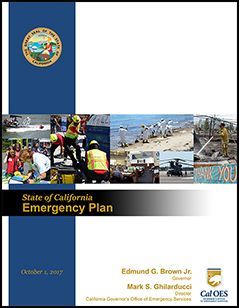About the Emergency Operations Plan (EOP)

Emergency Operations Plans (EOP) establish how the State, Tribal, or local jurisdiction manages its emergency response. While they are not required, they are common documents because they help with receiving funding. The plans include the following information:
- methods for conducting emergency operations,
- the process for seeking help from nearby jurisdictions (referred to as mutual aid),
- emergency services of government agencies,
- use of resources,
- how the public is informed,
- how to maintain continuity of government during an emergency,
- hazard mitigation actions to reduce risk, and
- preparedness and recovery from disaster.
The California Office of Emergency Services creates the State's EOP. Hospitals and universities have EOPs, too, and businesses have "Business Continuity Plans."
The State’s EOP represents the collective effort of emergency services professionals to protect California's communities, infrastructure, and the environment against natural and human-made threats and risks. The State's EOP informs operations and plans of the local Offices of Emergency Services. Tribal and local jurisdictions use it to create their EOPs.
Impact on frontline communities
Community groups have valuable insight into the needs of local frontline residents and are often the first in place to respond to community needs after a disaster. The Federal Emergency Management Agency's (FEMA) Community Planning and Development Division advocates for a collaborative EOP Planning team made up of community members in addition to technical experts. However, since community input is not required, public participation in EOPs in California is often limited. Community stakeholders need to have an opportunity to inform local plans to:
- ensure the plan meets community needs throughout disaster response,
- create community partnerships on the ground to advance the mutual needs of the community, and
- ensure an equitable and sustainable outcome for emergency management and move as quickly to the rebuilding phase as possible.
About cultural competence in Emergency Operations Planning
California has recognized the need to serve frontline communities in EOPs better. In October 2019, California's Governor signed Senate Bill 160, which requires local jurisdictions to integrate cultural competence into their next emergency plan update. It also requires a forum for engagement in "culturally diverse communities." Cultural competence, as defined in the law, is "the ability to understand, value, communicate with, and effectively interact with people across cultures to ensure the needs of all community members are addressed, with priority given to 'culturally diverse communities.'" Cultural competence means having the skills and knowledge to be in cross-cultural relationships.
Cultural competence is even more powerful when combined with cultural humility.
Cultural humility is acknowledging that your knowledge of another's person's cultural identity will always be partial, incomplete, and biased. It also means approaching each situation with curiosity and a desire to learn. Here is a great resource to learn more about practicing cultural humility.
Actions to take
For community-based organizations and affordable housing providers
- Look up your local and State EOP. Consider how it is meeting the needs of frontline communities and falling short.
- Offer to join the process of updating the plan and offer recommendations for what your community needs.
- Advocate at the Federal, State, and local levels for more money to go to local jurisdictions for this kind of work.
For State government
- Fund local jurisdictions to engage in updating the EOP with the inclusion of cultural competence and humility.
- Offer technical resources for how frontline communities can engage in EOP work.
- Offer funding to support local jurisdictions in turning the plan into a reality. For example, jurisdictions need money to fund translators to have response materials in several languages. Paying community members for their time is also crucial.
For local government
- Develop your staff’s cultural competence – for example, by using this training resource on learning about cultural competence and humility.
- Take an inventory of what relationships you currently hold with frontline communities and community-based organizations.
- If zero or very few, explore these questions: Why is this the situation? How can this become a priority? What learning is needed to engage with frontline communities appropriately?
- Are there community-based organizations that hold pre-existing relationships to help get started? If so, start the process today of working with them to better incorporate cultural competency and humility into the EOP if this isn’t already done.
- Create a Community Advisory Board to support the development and maintenance of the Emergency Operations Plan. The Board should include several representatives from various frontline communities.
- Integrate cultural competence and humility into other planning documents such as the General Plan and Hazard Mitigation Plan.
- Some examples of ideas that you might incorporate into your plan:
- Translators to be able to offer materials in other languages.
- A path to have multiple emergency notifications that reach people in their first language. Ensure that notifications are available to people with disabilities.
- Safe places for immigrants and people who are undocumented to evacuate.
- Ensure various formats and platforms for all materials (analog, social media, video) are available to community members.
- Assign mental health services to communities based on the needs of the various demographics. For example, using mental health providers that are familiar with the compounding trauma of frontline communities.
- Create a plan to work with local communities to conduct an Immediate Needs Assessment after a disaster.
For philanthropy
- Local jurisdictions don't usually have extra capacity or money to fund robust community engagement. Philanthropy can support these efforts by funding planning activities (including stipends for Advisory Board members from frontline communities) and implementing the strategy that emerges.
- Advocate at the Federal, State, and local levels for more money to go to local jurisdictions for this kind of work.
- Training